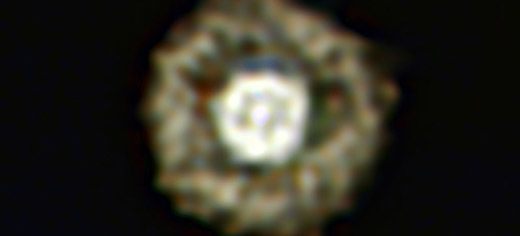
The final throes of one of the largest and rarest stars in our galaxy have been discovered by astrophysicists using the European Southern Observatory (ESO).
The discovery will enable research into the evolution of stars, and provide invaluable insight into their explosive deaths.
The research was carried out by academics from ESO, the Universities of Leeds and Manchester in the UK, and other institutions in Europe. It is to be published in the journal Astronomy & Astrophysics. Professor René Oudmaijer of the School of Physics & Astronomy at the University of Leeds provided his expertise on the evolution of stars.
Despite being catalogued in 1983, this is the first time the star, known as IRAS 17163-3907, has been identified as a yellow hypergiant. Out of a hundred billion stars in the Milky Way, this is only the third such monster star to be discovered.
The star is half a million times brighter than our Sun, but much of this light is given out in the infra-red part of the spectrum, making it relatively dim to traditional telescopes. It is for this reason, suggests Professor Oudmaijer, that it took over 25 years for someone to study it in great detail.
"The star has a volume one billion times that of the Sun. If it was placed in the centre of our solar system, Jupiter would orbit just above the star's surface. Its size means that sometime in the future it will go supernova", said Professor Oudmaijer.
The dust and gas belched out by these stars can be seen in the two shells that surround the star. The first was puffed out almost a thousand years ago, but the inner shell was ejected within the last 300 years. The radius of these shells will tell astrophysicists about what massive stars do as they approach a supernova.
The appearance of the two spherical shells, led the researchers to dub the star the 'Fried Egg Nebula'.
Professor Oudmaijer said that the star could help us to learn much more about stellar evolution. He said, "Every now and then, we have a big leap forward in our understanding. This could be one of those moments. It's a very rare object from a stellar evolution perspective, and the double shell is a particularly important discovery. It tells us for the first time that material is ejected during several periods and not steadily in this late phase of a star's life".
"The next gasp might be this giant star's last one," noted Professor Oudmaijer.
Professor Oudmaijer added: "As well as insights into stellar evolution, physicists hope to learn more about how massive stars influence galaxies. For example, the strong winds from these types of star are so powerful that they influence the shape of galaxies".
For more information
Contact: Communications & Press Office, University of Leeds
T: 0113 343 4031; E: pressoffice@leeds.ac.uk
Notes to Editors
1. The name indicates that the object was first spotted as an infrared source by the IRAS satellite in 1983 and the numbers show the star's place in the sky, in the heart of the Milky Way in the constellation of Scorpius (The Scorpion).
2. The research was undertaken by Dr Eric Lagadec, European Southern Observatory, Professor Albert Zijlstra, School of Physics and Astronomy, University of Manchester, Professor Rene Oudmaijer, School of Physics & Astronomy, University of Leeds, Dr Tijl Verhoelst and Dr Nick Cox, Instituut voor Sterrenkunde, Leuven, Belgium, Dr Ryszard Szczerba, Nicolaus Copernicus Astronomical Center, Torun, Poland, Djamel Mékarnia, Observatoire de la Cí´te d'Azur, Nice, France, and Hans van Winckel, Instituut voor Sterrenkunde.